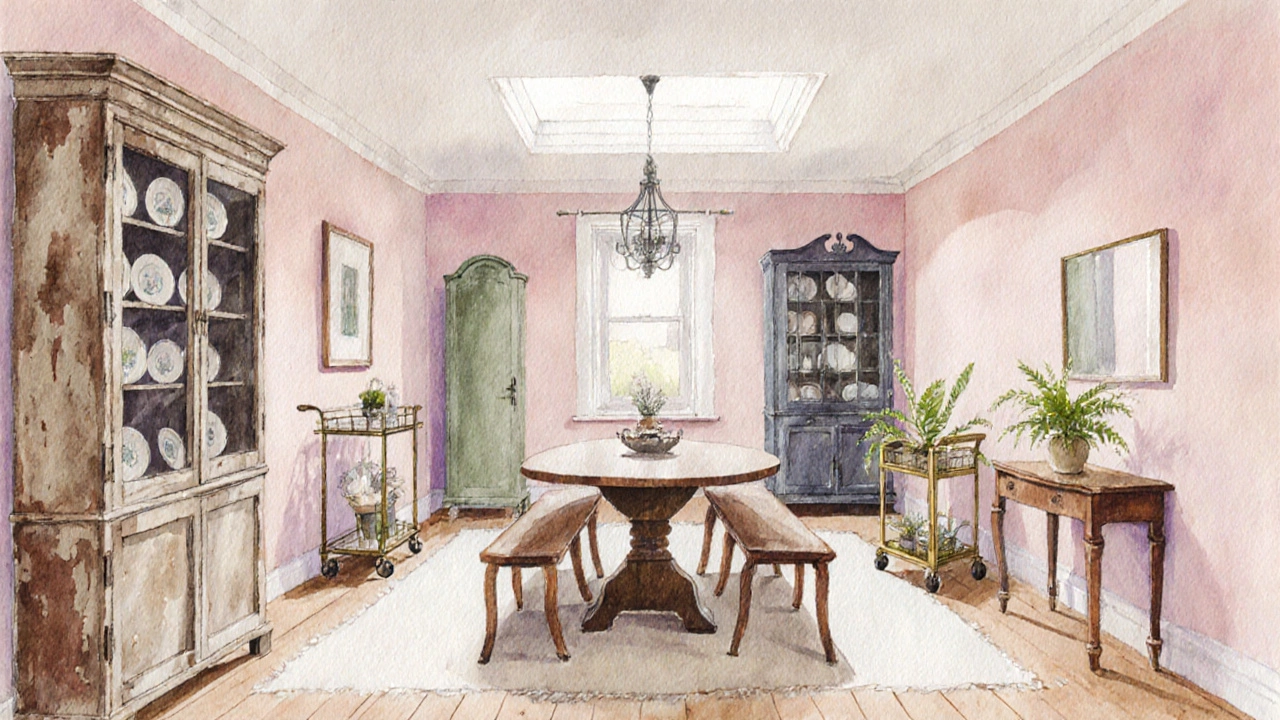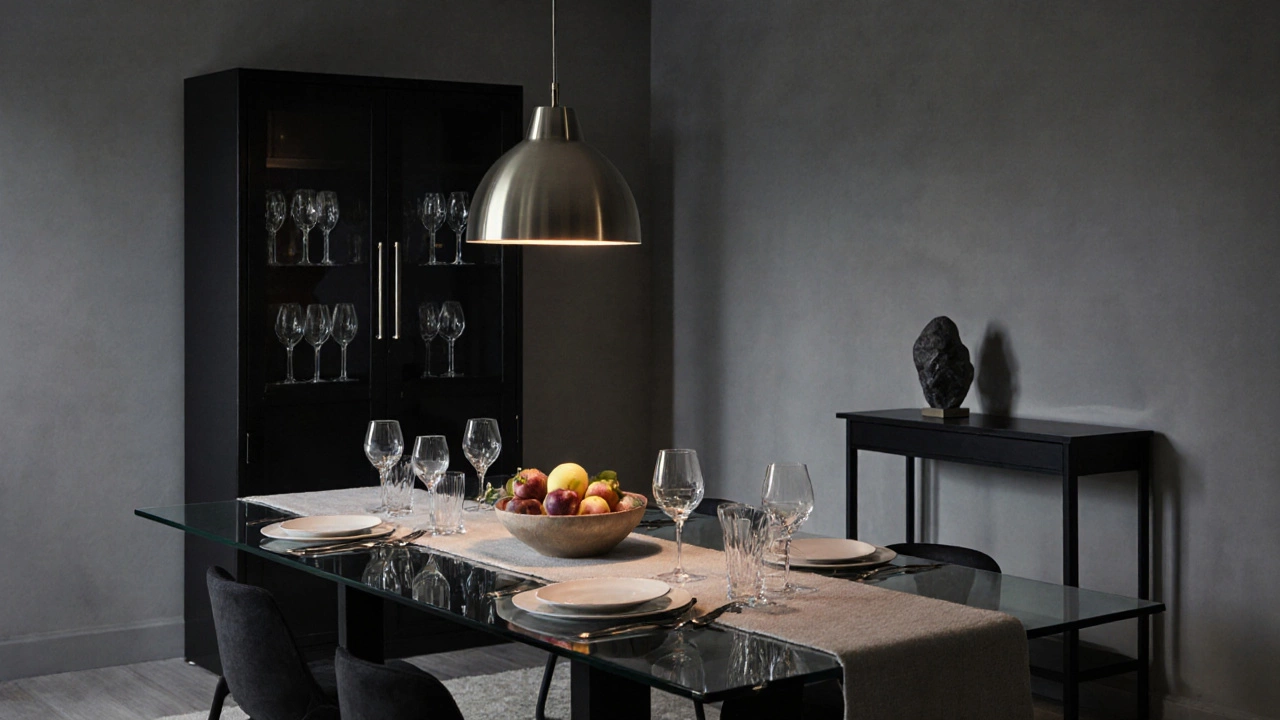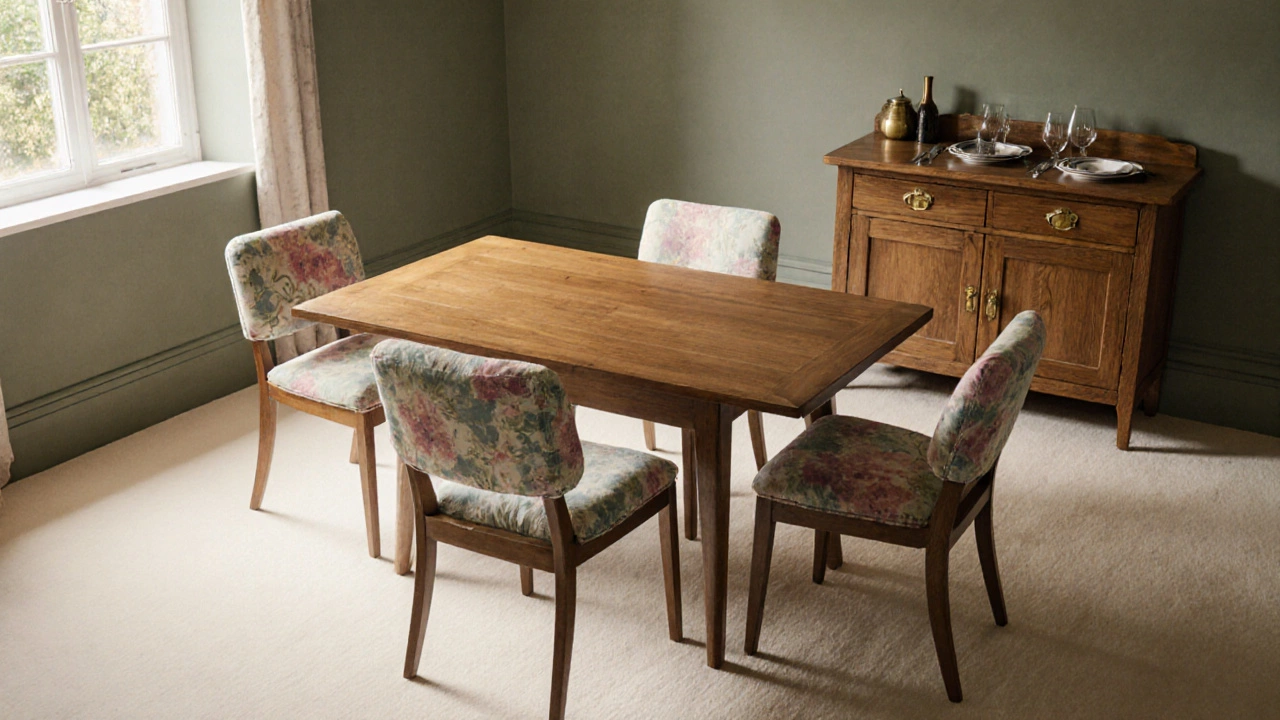Dining Room Space Calculator
Measure your room dimensions and select furniture pieces to see if they fit with proper clearance.
When you step into a dining room, the pieces you see aren’t just random objects - they’re a carefully chosen set of dining room furniture that together shape how you eat, entertain, and relax.
What Counts as Dining Room Furniture?
Dining room furniture is a collection of functional pieces designed specifically for the dining area. It typically includes a table, seating, storage, and accessories that support meals and gatherings. While the core items stay the same, styles, sizes, and additional pieces evolve with trends and personal taste.
The Core Pieces: Table and Seating
Every dining space starts with a Dining table. This is the centerpiece where meals are served and conversations happen. Tables range from small round bistro models (about 30‑inch diameter) perfect for two, to expansive rectangular surfaces (up to 96 inches long) that can host a family of eight.
Supporting the table are Dining chairs. Chairs come in countless forms - upholstered for comfort, wooden for a classic look, or even metal for an industrial vibe. When choosing chairs, consider seat height (usually 18‑20 inches from floor to seat) and backrest style, as both affect comfort and visual balance.
Secondary Storage: Sideboards, Buffets & Hutch
Beyond the table and chairs, many homes add storage pieces to keep dishes, linens, and serving ware out of sight. A Sideboard (sometimes called a buffet) is a low, wide cabinet that sits against a wall. Typical dimensions are 60‑80 inches wide, 16‑20 inches deep, and 30‑36 inches high. Sideboards often feature drawers for flatware and cabinets for plates.
A Hutch combines a sideboard base with an upper cabinet or display case. It provides extra shelving for glassware and decorative pieces while keeping the footprint similar to a sideboard. Hutch heights usually reach 70‑80 inches, making them a visual anchor in larger rooms.
Specialty Pieces: China Cabinet, Bar Cart, Bench & Console
A China cabinet is a tall, glass‑fronted display case meant for fine dinnerware. It often includes adjustable shelves and can stand 60‑70 inches tall, offering a museum‑like showcase for heirloom plates.
For homes that love casual entertaining, a Bar cart adds mobility. These narrow, wheeled units (usually 30‑35 inches high) roll near the dining table, holding drinks, cocktail tools, and small snacks.
A Bench offers flexible seating, especially for farmhouse or industrial styles. A bench can seat three or four people on one side of the table, saving space compared to individual chairs.
Finally, a Console table placed behind the dining chair line can serve as a decorative surface for artwork, plants, or a decorative bowl.

How to Choose the Right Pieces for Your Space
- Measure first. Determine the room’s dimensions and leave at least 30‑36 inches of walking space around the table.
- Define the function. If you host large dinner parties, prioritize an extendable table and extra seating like benches.
- Match the style. Classic wood tones pair well with formal sideboards, while sleek metal chairs complement a modern glass table.
- Consider storage needs. Small families may get by with a simple sideboard, while avid entertainers often need a hutch or china cabinet.
- Plan for growth. Choose modular pieces that can be added later, such as a bar cart that doubles as a serving station.
Arranging Your Dining Room Layout
Good layout ensures smooth flow and visual harmony. Follow these guidelines:
- Place the table centrally, allowing equal clearance on all sides.
- Align sideboards or buffets against a wall opposite the table, creating a balanced visual line.
- If using a hutch, position it on the same wall as the sideboard for a unified storage zone.
- Bench seating should be placed on the longer side of a rectangular table to maximize space.
- Keep the bar cart mobile - push it in when needed, tuck it out of the way otherwise.
Styling Tips: From Casual to Formal
Styling breathes personality into each piece. Here are quick ideas:
- Casual farmhouse: Reclaimed wood table, mixed metal chairs, a bench, and a distressed sideboard.
- Modern sleek: Glass-top table, acrylic chairs, low-profile console, and a minimalist hutch with brushed nickel handles.
- Traditional elegance: Dark mahogany table, upholstered wingback chairs, a polished china cabinet, and a classic bar cart in polished brass.

Maintenance and Longevity
Proper care extends the life of your dining room pieces. Follow these basics:
- Dust wooden surfaces weekly with a soft cloth; avoid abrasive cleaners.
- Use coasters and placemats to protect table finishes from heat and spills.
- Rotate bench cushions every few months to avoid uneven wear.
- Clean glass doors of china cabinets with a vinegar‑water solution to prevent streaks.
- Wipe bar cart wheels regularly to keep them rolling smoothly.
Quick Reference Table
| Furniture Type | Typical Size (L×W×H) | Primary Function | Typical Placement |
|---|---|---|---|
| Dining table | 48-96" × 30-40" × 30" | Meal surface | Center of room |
| Dining chairs | 18-20" × 18-20" × 35-40" | Seating | Around table |
| Sideboard / Buffet | 60-80" × 16-20" × 30-36" | Storage & serving | Against wall |
| Hutch | 60-80" × 20" × 70-80" | Elevated storage/display | Above sideboard |
| China cabinet | 30-36" × 20" × 60-70" | Display fine china | Near dining set |
| Bar cart | 30-35" × 15" × 30-35" | Mobile drink station | Adjacent to table |
| Bench | 48-72" × 16" × 15‑18" | Seating | Side of table |
| Console table | 40-60" × 12‑16" × 30" | Decorative surface | Behind chairs |
Frequently Asked Questions
What size dining table should I choose for a small apartment?
A 36‑inch round table or a 48‑inch rectangular table works well; it fits the space while still seating four people comfortably.
Can I mix different chair styles around the same table?
Yes, as long as the chair heights are consistent. Mixing materials (wood + metal) adds visual interest without sacrificing comfort.
Is a hutch necessary if I already have a sideboard?
Not strictly. A hutch adds vertical storage and display space, useful for glassware or decorative items that a sideboard alone can’t showcase.
How do I protect a wooden dining table from scratches?
Use coasters, placemats, and a protective finish like polyurethane. A tablecloth for daily use also helps.
What’s the benefit of a bar cart versus a sideboard?
A bar cart is mobile, allowing you to bring drinks directly to guests, while a sideboard provides larger storage but stays stationary.
Next Steps for Your Dining Room Refresh
Start by measuring your space and sketching a simple floor plan. Then pick a table size that fits your most common gatherings. Add chairs or a bench that match your style, and decide if you need extra storage like a sideboard or hutch. Finally, layer in accessories - a runner, decorative bowls, or a statement light fixture - to make the room feel personal.
With the right pieces, your dining room transforms from a functional area into a welcoming hub for meals, celebrations, and everyday conversation.


